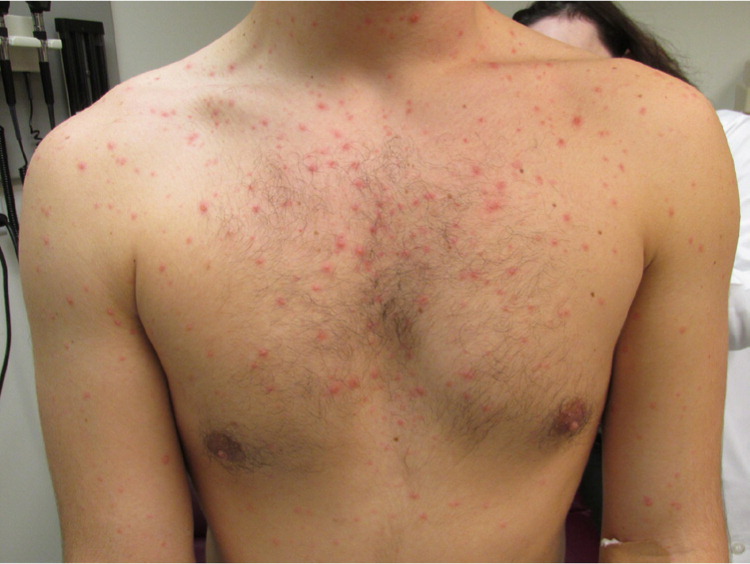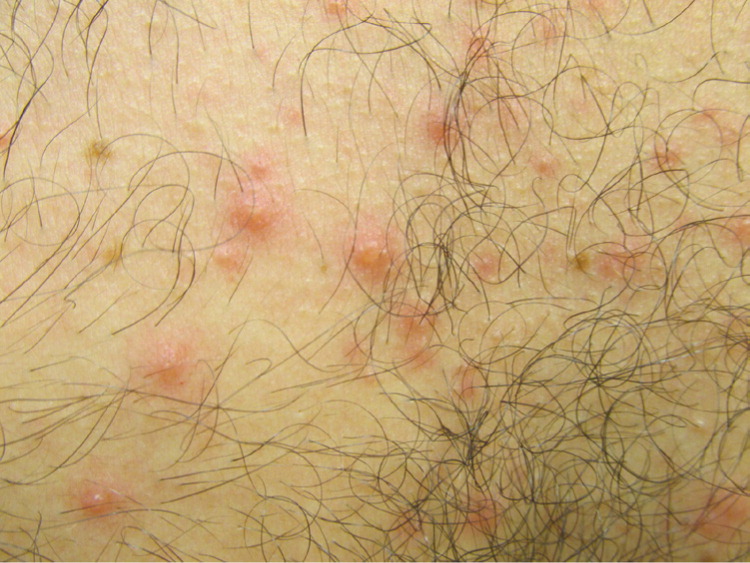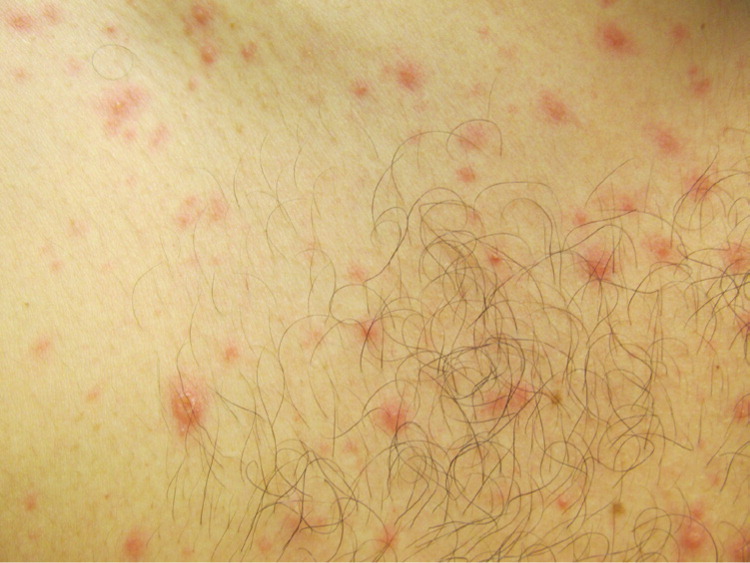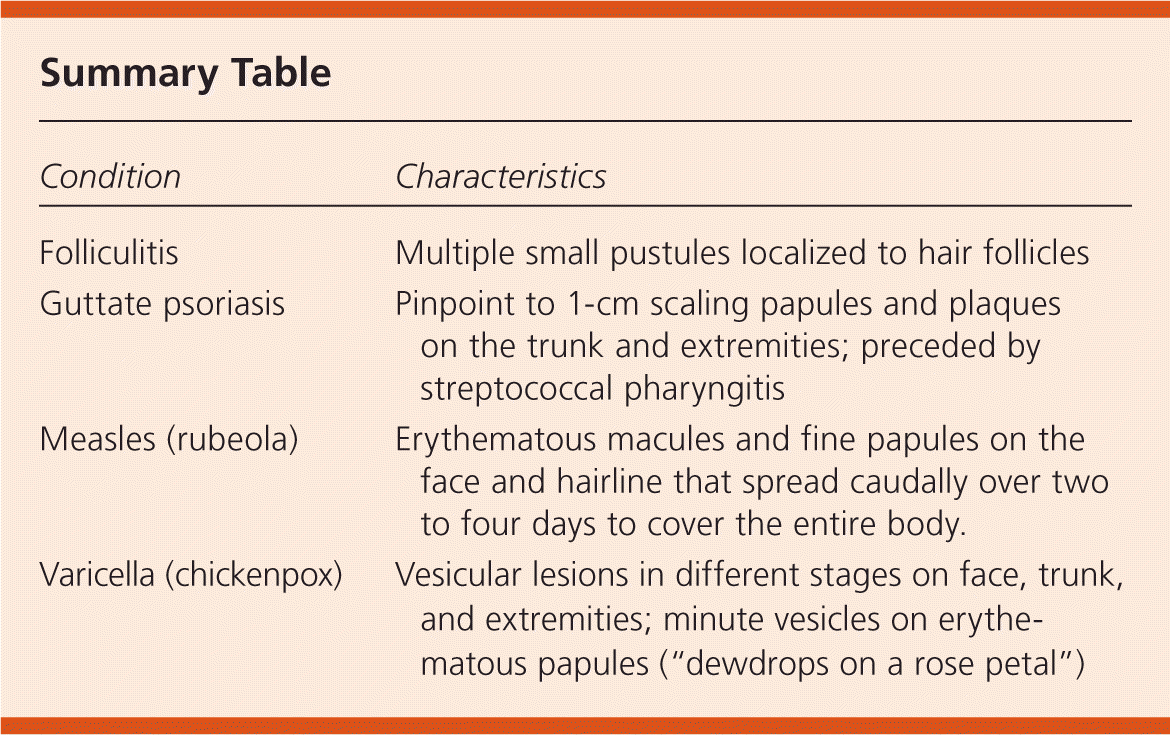
Am Fam Physician. 2015;91(3):195-196
Author disclosure: No relevant financial affiliations.
A 19-year-old college student presented with a rash that he first noticed two days prior. The rash initially consisted of four pimple-like lesions on his forehead. No pus or fluid could be expressed from the lesions. Additional lesions rapidly developed on his scalp, face, and trunk. The rash became intensely pruritic, and some lesions became painful. He also had a cough, sore throat, subjective low-grade fever, and decreased energy.
He was under increased stress because of college examinations, but he was eating and drinking normally and able to keep up with his studies. He was born in a refugee camp in Germany. Although he was unsure about his vaccination history, he believed his vaccinations were up to date. He had not traveled recently.
The physical examination revealed 3- to 4-mm erythematous papules and 1- to 2-mm vesicles on an erythematous base (Figures 1 through 3) that were scattered over his face, scalp, trunk, and upper extremities. The highest concentrations were on his face and central trunk. The lesions were present in multiple stages, some with crusting and excoriation.



Question
Discussion
The correct answer is D: varicella (chickenpox). The diagnosis of varicella is generally clinical, although it has become rare because of childhood varicella vaccination. Varicella is a highly contagious infection caused by the varicella zoster virus transmitted via airborne droplets or vesicular fluid.1 Patients are contagious for two days prior to the appearance of the rash and until all lesions have crusted.1 Prodromal symptoms of low-grade fever, headache, and malaise can appear directly before or at the onset of the rash.1 Symptoms may be more severe in adults.1
Primary infection with varicella zoster virus is characterized by vesicular lesions in different stages of development on the face, trunk, and extremities.2 The rash consists of minute vesicles on erythematous papules, commonly referred to as “dewdrops on a rose petal” because of their appearance.1 A key clinical finding in the diagnosis of varicella is crops of characteristic lesions including papules, vesicles, pustules, and crusted lesions in different stages that are present simultaneously.3
Laboratory testing (e.g., Tzanck smear, direct fluorescent antibody testing, viral culture, viral polymerase chain reaction) can confirm varicella. Viral polymerase chain reaction offers rapid results with high sensitivity and specificity. Treatment is generally supportive but can include oral antiviral medications, which decrease the time to cutaneous healing, the duration of fever, and symptom severity.1
Folliculitis is characterized by multiple small pustules localized to hair follicles on the body surface. The presence of a hair follicle at the center of each pustule is the key to diagnosis.3
Guttate psoriasis is characterized by pinpoint to 1-cm scaling papules and plaques on the trunk and extremities. This rash is often preceded by streptococcal pharyngitis one to two weeks before eruption. Scaly lesions and history of streptococcal pharyngitis are key findings in the diagnosis.3
Measles (rubeola) has an incubation period of eight to 12 days. It is preceded by a prodrome of fever, rhinitis, cough, conjunctivitis, and grayish mucosal lesions known as Koplik spots. The rash appears one to seven days following the prodrome and consists of erythematous macules and fine papules. The lesions first appear on the face and hairline and subsequently become confluent and spread caudally over two to four days to cover the entire body. The lesions tend to fade in the order that they appeared and may leave a brown discoloration that fades over weeks to months.1

| Condition | Characteristics |
|---|---|
| Folliculitis | Multiple small pustules localized to hair follicles |
| Guttate psoriasis | Pinpoint to 1-cm scaling papules and plaques on the trunk and extremities; preceded by streptococcal pharyngitis |
| Measles (rubeola) | Erythematous macules and fine papules on the face and hairline that spread caudally over two to four days to cover the entire body. |
| Varicella (chickenpox) | Vesicular lesions in different stages on face, trunk, and extremities; minute vesicles on erythematous papules (“dewdrops on a rose petal”) |
